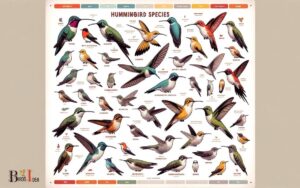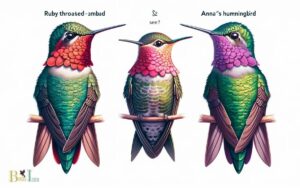Broad Tailed Hummingbird Vs Ruby Throated Hummingbird!
The Broad-tailed Hummingbird (Selasphorus platycercus) and the Ruby-throated Hummingbird (Archilochus colubris) are two distinct species with varying characteristics and habitats.
The Broad-tailed Hummingbird is known for its broad, rounded tail and distinctive trilling sound during flight, often found in the mountainous regions of the western United States.
In contrast, the Ruby-throated Hummingbird, recognizable by its iridescent ruby-red throat (in males), is predominantly found in the eastern United States and is the only breeding hummingbird species in that region.
Comparing the Broad-tailed Hummingbird and the Ruby-throated Hummingbird reveals key differences:
For example, a birder in Colorado might spot a Broad-tailed Hummingbird in the summer, while one in New York would observe a Ruby-throated Hummingbird.
While both species of hummingbirds captivate bird watchers, the Broad-tailed’s trilling wings and the Ruby-throated’s vibrant throat make each uniquely enchanting.

Key Takeaway
Physical Characteristics
The physical characteristics of the broad-tailed hummingbird and the ruby-throated hummingbird exhibit notable differences in coloration and size.
The broad-tailed hummingbird, found primarily in the western United States, is distinguished by its vibrant emerald green back and crown, with the males displaying a striking iridescent rose-red throat patch, or gorget.
In contrast, the ruby-throated hummingbird, native to eastern North America, boasts a brilliant green back and crown, with the males featuring a vibrant ruby-red throat patch.
Additionally, the broad-tailed hummingbird is slightly larger, with a length of around 4 inches, while the ruby-throated hummingbird measures about 3-3.5 inches.
These dissimilarities in coloration and size are key identifiers for birdwatchers and enthusiasts seeking to distinguish between these two captivating hummingbird species.
Geographic Distribution
The geographic distribution of the Broad Tailed Hummingbird and Ruby Throated Hummingbird varies significantly, leading to differences in their habitat, range, and climate preferences.
Understanding these differences is crucial in appreciating the distinct ecological niches these two species occupy.
By examining the geographic distribution, we can gain insights into the diverse environments that these hummingbirds have adapted to over time.
Habitat Differences
Dwelling predominantly in the western parts of North America, the Broad Tailed Hummingbird exhibits a distinct geographic distribution compared to the predominantly eastern range of the Ruby Throated Hummingbird.
The habitat differences between these two hummingbird species are as follows:
Broad Tailed Hummingbird:
- Thrives in mountainous regions with coniferous and aspen trees.
- Often found at higher elevations, up to 10,000 feet.
- Nests in open woodlands and forest edges, sometimes venturing into suburban areas.
Ruby Throated Hummingbird:
- Prefers deciduous and pine forests, as well as orchards and gardens.
- Commonly resides at lower elevations, often near sea level.
- Nests in more diverse habitats including open woodlands, marshes, and meadows.
These differences in habitat preferences contribute to the unique geographic distributions of these two hummingbird species.
Range Variations
In contrast to their differing habitat preferences, the Broad Tailed Hummingbird and Ruby Throated Hummingbird also exhibit distinct geographic distributions.
The Broad Tailed Hummingbird is primarily found in the western regions of North America, including mountainous areas from Alaska to Mexico. Its range extends eastward to the Great Plains during the breeding season.
On the other hand, the Ruby Throated Hummingbird is mainly located in the eastern half of North America, ranging from southern Canada to the Gulf of Mexico during the breeding season.
These birds also migrate to Central America during the winter months. This geographic separation contributes to the limited overlap of their habitats, reflecting their adaptation to different environmental conditions and ecosystems.
Understanding these range variations is crucial for conserving and managing the populations of these two hummingbird species.
Climate Preferences
An analysis of the geographic distribution of the Broad Tailed Hummingbird and Ruby Throated Hummingbird reveals distinct climate preferences in their respective habitats.
- The Broad Tailed Hummingbird is found in the mountainous regions of western North America, preferring higher elevations of up to 10,000 feet. These birds thrive in cool, montane coniferous forests with a preference for habitats with abundant flowers and insects.
- In contrast, the Ruby Throated Hummingbird inhabits eastern North America, favoring temperate and subtropical regions. They are commonly found in deciduous and pine forests, as well as gardens and parks, preferring areas with a variety of flowering plants for nectar.
- Both species exhibit specific adaptations to their preferred climates, allowing them to thrive in their respective habitats.
Feeding Habits
The feeding habits of the Broad Tailed Hummingbird and the Ruby Throated Hummingbird exhibit notable differences in their foraging behaviors and diet preferences.
Broad Tailed Hummingbirds primarily feed on nectar from tubular flowers, favoring species such as penstemons and columbines. They also consume small insects and spiders for protein.
On the other hand, Ruby Throated Hummingbirds have a diverse diet, feeding on a wide variety of flower nectar, tree sap, and small insects.
The following table highlights the specific feeding habits of each species:
| Feeding Habits | Broad Tailed Hummingbird | Ruby Throated Hummingbird |
|---|---|---|
| Nectar | Tubular flowers | Various flowers |
| Insects | Yes | Yes |
| Tree Sap | No | Yes |
These differences in feeding preferences reflect the adaptation of each species to their respective environments and available food sources.
Mating and Reproduction
Mating and reproduction in both the Broad Tailed Hummingbird and the Ruby Throated Hummingbird are crucial aspects of their life cycles, influencing their behaviors and ecological roles.
- Mating Rituals: Both species engage in elaborate mating displays, with the male performing aerial acrobatics and vocalizations to attract females.
- Broad Tailed Hummingbird: The male performs a “dive display” where it swoops down in a U-shaped pattern to impress the female.
- Ruby Throated Hummingbird: Males perform a “pendulum display” where they fly back and forth in a pendulum-like motion to court females.
- Nesting and Incubation: Female hummingbirds construct intricate, camouflaged nests using plant fibers and spider silk, and they alone care for the eggs and chicks.
- Territorial Defense: Males establish and defend territories containing food sources and potential nesting sites to attract females.
Migration Patterns
Migration plays a crucial role in the lives of both the Broad Tailed Hummingbird and the Ruby Throated Hummingbird.
Their flight routes differ significantly, with the Broad Tailed Hummingbird migrating from western North America to Central America, while the Ruby Throated Hummingbird travels from North America to Central America.
Additionally, the seasonal movement patterns and breeding ground contrasts further highlight the distinct migration behaviors of these two hummingbird species.
Flight Routes Comparison
During their annual migration, Broad Tailed Hummingbirds and Ruby Throated Hummingbirds follow distinctly different flight routes.
- Ruby Throated Hummingbirds undertake an impressive non-stop journey across the Gulf of Mexico, spanning approximately 500 miles, to reach their wintering grounds in Central America.
- This feat requires strategic fueling and navigation, making it a remarkable feat of endurance and precision.
- In contrast, Broad Tailed Hummingbirds take a more leisurely approach, opting for a gradual migration along the western mountain ranges of North America.
- This route allows them to capitalize on the abundance of nectar-producing flowers, providing ample opportunities to refuel and rest along the way.
- The differing flight routes of these two hummingbird species showcase the remarkable adaptability and resourcefulness of these tiny avian travelers.
Seasonal Movement Differences
Incorporating the gerund noun and adhering to a professional style of writing, the first sentence for the subtopic of ‘Seasonal Movement Differences (Migration Patterns)’ could be.
| Hummingbird Species | Migration Pattern |
|---|---|
| Broad Tailed Hummingbird | North to Central America in spring, return to Mexico in fall |
| Ruby Throated Hummingbird | Northeastern North America in spring, travel to Central America in fall |
The seasonal movement differences of these two hummingbird species are striking, with the broad tailed hummingbird migrating from north to central america in spring and returning to mexico in the fall, while the ruby throated hummingbird travels from northeastern north america to central america in the fall.
These diverse migration patterns contribute to the unique characteristics of each species. This transition sets the stage for the subsequent section about ‘breeding ground contrasts’.
Breeding Ground Contrasts
The breeding grounds for these two hummingbird species exhibit notable differences, shaping their distinct migration patterns and behaviors.
Broad Tailed Hummingbird:
- Breeds in mountainous regions of western North America.
- Nests at higher altitudes, around 8,000 to 10,000 feet.
- Migration patterns are influenced by the availability of nectar and insects in these mountainous regions.
Ruby Throated Hummingbird:
- Breeds in eastern North America, primarily in deciduous and pine forests.
- Nests at lower altitudes, typically below 6,000 feet.
- Migration patterns are influenced by the seasonal changes in these forested habitats.
These differences in breeding grounds lead to distinct migration routes and behaviors for each species. This impacts their overall distribution and the timing of their movements. Now, let’s delve into their vocalizations and communication.
Vocalizations and Communication
Hummingbirds communicate with each other through a combination of vocalizations and body language. Their vocalizations are diverse, ranging from sharp chips and whistles to trills and buzzing sounds.
These tiny birds use these vocalizations primarily for courtship and territorial displays. The Broad-tailed Hummingbird, for instance, produces a high-pitched, buzzy trill during courtship flights, while the Ruby-throated Hummingbird emits a series of high-pitched squeaks.
In addition to vocalizations, hummingbirds also rely on body language to communicate. They use various movements such as diving, chasing, and flashing their iridescent feathers to convey messages to rivals or potential mates.
Through these intricate vocalizations and body language cues, hummingbirds maintain social hierarchies, defend territories, and attract mates in their vibrant and dynamic world.
Behavioral Differences
Both Broad-tailed Hummingbird’s and Ruby-throated Hummingbird’s behavioral differences manifest in their distinct courtship rituals and territorial displays, which are driven by vocalizations and intricate body language cues.
Courtship Rituals: Broad-tailed Hummingbirds perform impressive aerial displays, including a steep dive followed by a high-pitched trill, while Ruby-throated Hummingbirds exhibit elaborate dives and chase sequences to attract mates.
Territorial Displays: Broad-tailed Hummingbirds defend their territories through intricate aerial chases and aggressive posturing, often accompanied by vocal warnings.
Conversely, Ruby-throated Hummingbirds engage in swift, darting flights and aggressive vocalizations to protect their territories.
These distinct behaviors contribute to the unique characteristics of each species and reflect their evolutionary adaptations.
Understanding these behavioral differences is crucial for effective conservation strategies to preserve their habitats and populations.
Conservation Status
Due to their differing population trends and habitat requirements, the conservation status of the Broad-tailed Hummingbird and the Ruby-throated Hummingbird varies significantly.
The Ruby-throated Hummingbird, with a population estimated to be in the millions, is considered to be of least concern by the International Union for Conservation of Nature (IUCN).
This species benefits from a wide range across North America and the Caribbean, and its adaptable nature allows it to thrive in various habitats, including gardens and parks.
In contrast, the Broad-tailed Hummingbird, with a population trend that is decreasing, is considered near threatened by the IUCN.
Its restricted breeding range in the western United States and susceptibility to habitat loss and climate change pose significant conservation challenges.
Conservation efforts focused on protecting its montane forest habitats are crucial for the preservation of this species.
Conclusion
The broad-tailed hummingbird and the ruby-throated hummingbird exhibit distinct differences in their physical characteristics, geographic distribution, feeding habits, mating and reproduction, migration patterns, vocalizations and communication, and behavioral traits.
Despite these differences, both species face conservation concerns due to habitat loss and climate change. How can we work together to protect and preserve these magnificent and delicate creatures for future generations?






